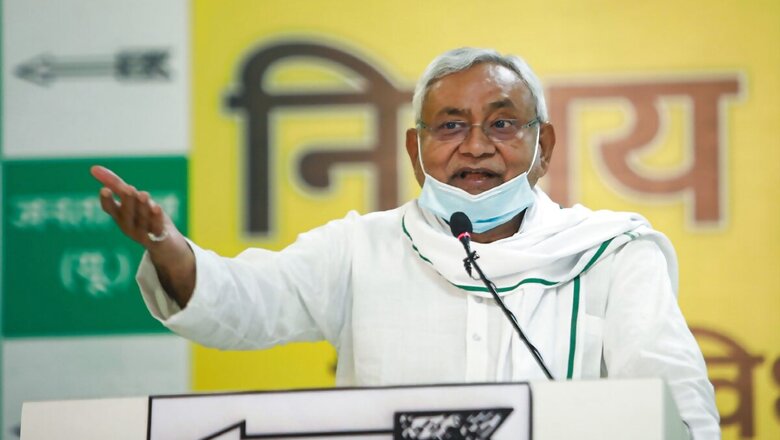
views
When Nitish Kumar took over from Rabri Devi in 2005, the state finances were far from satisfactory. Since 2000-01, the annual growth rates for the entire Bihar economy hovered between 5 and 6 per cent. The state’s economy was lagging behind the national average on various growth indices. “Bihar suffered not because of bad governance but because of a lack of governance,” Nitish famously said at the time.
The reversal in the state’s economic fortunes began soon. The revenue account which faced a deficit turned into surplus from 2004-05 onwards. For ten years between 2004-05 and 2014-15, it remained the fastest-growing state in India, managing an over 10% annual growth rate.
According to the state’s latest economic survey, Bihar registered 10.53% growth in 2018-19, better than the national average.
However, the biggest challenge Nitish as the new CM in 2005 faced was on the law-and-order front. With an average of over 10 murders and 4 dacoities a day in 2004, the state had acquired the infamous reputation of being India’s crime capital, with “jungle raj”, a term first used by the Patna High Court to describe the lawlessness.
For criminals and organised gangs, “apharan” or kidnapping for money had acquired the status of a mini-industry. Between 2000 and 2005, 1,778 cases of kidnapping for money were registered, according to Bihar Police data. Many cases allegedly went unreported as victims feared going to the authorities would further invite reprisal.
“The law-and-order system here is so fragile and moth-eaten that if I take drastic measures, things will crumble. But there is no alternative; I will have to do it. I will do it carefully,” Nitish had said in an interview to a news outlet back then.
Once in the chair, Nitish initiated a series of steps which soon started bearing fruit. The crime data shared by state police bears testimony to his success in controlling the law-and-order situation.
The state witnessed a 33% decline in annual murder cases in 2016 when compared to 2004, the penultimate year of the RJD’s rule. Though it had risen in 2019, the fall remained 19% compared to 2004 cases.
Other crimes too showed a similar declining trend. 411 cases of kidnapping for ransom were registered in 2004 which came drastically down to just 43 last year. 30 incidents of bank dacoity were reported from the state in 2004 which came down to 12 cases in 2019. Likewise, 1,297 cases of dacoity were registered in 2004 and just 391 cases last year. Robbery cases too declined from 2,909 in 2004 to 1,410 in 2016 and 2,399 cases last year.
Besides cracking down on criminals and entrenched syndicates, a series of legal reforms and capacity augmentation programmes were also launched. The sanctioned manpower strength of Bihar Police was drastically increased by 53,873 or 62% — from 86,801 in 2005 to 1,40,674 last year. In January 2005, Bihar had 834 police stations which was gradually increased to 1,074 by January last year. To speed-up the legal system, fast-track courts were launched along with an improved witness-protection programme.
Road infrastructure and connectivity is another turnaround story for which the Nitish government is remembered. While RJD boss Lalu Prasad Yadav had once famously remarked that he’ll make the roads of Bihar “as smooth as Hema Malini’s cheeks”, and it was under Nitish that Lalu’s dream was realised.
Despite its meagre economic resources, Bihar was the sixth highest among states in terms of building additional road length (1,30,799 km), during 2008-2017, according to figures quoted in the latest Bihar Economic Survey. During the past fifteen years, road density has increased from 245 km per lakh of population to 386 km per lakh of population of the state. Presently, Bihar has a road network of 2,09,549 km which includes 4,839 km of national highways (NH) and 4,006 km of state highways (SH).
The length of the paved rural roads has increased to 92,204 km in 2019, from 48,794 km in 2015, according to government figures.
As chief minister, Nitish also successfully reversed the power situation in the state, once notorious for its frequent outages and low per capita power consumption. The peak power deficit which till 2012-13 was around 32%, according to the state’s economic survey, substantially decreased to only 3% in 2018-19.
Power availability in rural areas, which was limited to an average of 6-8 hours a day, increased to 20-22 hours. Likewise, in urban centres it increased to 22-24 hours from just 10-12 hours earlier, says the state’s 2019 economic survey. The per capita power availability too saw an upswing from 78.0 kWh in 2004-05 to 287.3 kWh in 2018-19, a rise of over 268%, though it still remains the lowest in the country.
Furthermore, by December 2017, the state government successfully connected all of Bihar’s 39,073 villages to electricity grids besides providing power to all 1.06 lakh rural habitations by April 2018. A total of the state’s 1.40 crore households were provided with power connections compared to mere 24 lakh households in 2005.
In 2007-08, Kumar launched his landmark scheme Mukhya Mantri Balika Cycle Yojna — the chief minister’s cycle scheme for girl students. Female students in class IX were given Rs 2,000 cash from the state to buy bicycles. The scheme proved to be a game changer in a feudal state like Bihar with a drastic increase in enrolment of girls. The programme to some extent also helped reverse the dropout rate of girl students.
Data provided by the state government’s education department shows that the overall dropout rate (for both boys and girls) fell from 51.6% in 2004-05 to just 16.2% in 2017-18 for primary classes. For secondary programmes, it fell to 56.1% in 2017-18 from a high of 83.06% in 2004-05.
In higher education, the state now has 33 universities including 19 state, 4 central, 7 private and a deemed university, much higher than the 13 universities it had when Nitish took the reins.
However, despite these towering achievements, 15 years is too long a time in power in this age of quick resentment. Also, Bihar’s fast and high growth did not help much in countering poverty and arresting a job crisis. All of Nitish’s efforts to bring in investment in the state came to a naught soon, so much so that no serious effort was made to industrialise Bihar. The result is for everyone to see.
Read all the Latest News, Breaking News and Coronavirus News here




















Comments
0 comment